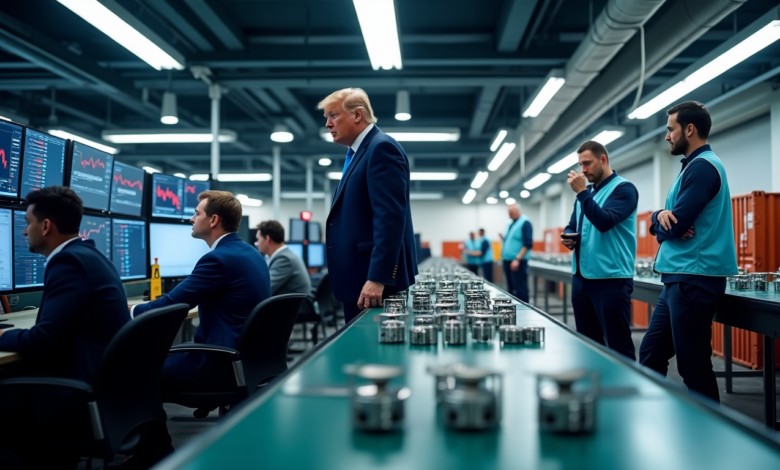
Trump’s Policy Rush Triggers International Trade Tensions
A recent working paper reveals that Trump’s economic policies could lead to a major GDP drop of up to 9.65% in the United States by 2028. The former President has started to make big changes in policy. He plans to pull out of the World Health Organization and pause foreign aid for 90 days. These decisions are already affecting global markets. The U.S., which gives 16-18% of WHO’s revenue as its biggest donor, will end its membership by January 2026. The analysis shows that while these policies might slow down America’s economic growth, 21 other countries could see their GDP grow during this time. These changes will alter the global economic landscape. American economic policy’s radical shift will hit sectors like agriculture and durable goods manufacturing hard.
Trump Announces Sweeping Economic Policy Changes
President Donald Trump announced major economic policy changes through executive orders that implement a 25% tariff on goods from Canada and Mexico, along with a 10% levy on Chinese imports. These sweeping changes will take effect on February 4, 2025, and they triggered immediate market responses.
Key policy shifts shake markets
These policy changes go beyond simple tariffs. Trump’s administration wants to lower corporate tax rates to 15% for domestic manufacturers and plans to make the 2017 Tax Cuts and Jobs Act provisions permanent. The administration also proposed eliminating taxes on Social Security benefits and expanding the Child Tax Credit to USD 5,000 per child from USD 2,000.
Wall Street reacts to announcements
Financial markets had dismissed Trump’s tariff threats as negotiating tactics but now face a stark reality check. The Dow Jones Industrial Average dropped more than 500 points, which led to major currency fluctuations. The Mexican peso and Canadian dollar saw sharp declines, with Canada’s currency falling to its lowest value against the US dollar since 2003.
Wall Street economists project serious consequences from these policies:
- Morgan Stanley forecasts US inflation could rise by 0.3% to 0.6%, pushing headline personal consumption expenditures inflation to 2.9%-3.2%, with GDP growth potentially declining by 0.7% to 1.1% over the next 3-4 quarters
US growth faces economic pressure as countries move away from US exports. Federal receipts could increase by an estimated USD 1 trillion over the next decade. Deutsche Bank analysts suggest these policies could push Canada and Mexico into an imminent recession if implemented and prolonged, marking a dramatic change in North American economic relations.
Federal Reserve Faces New Pressures Under Trump
The Federal Reserve keeps interest rates steady between 4.25% and 4.5% despite growing pressure from the White House.
How Fed independence affects monetary policy
Fed Chair Jerome Powell strongly defends the central bank’s independence. He stresses that keeping monetary policy free from political influence helps “the benefit of all Americans”. The Fed now faces direct challenges as Trump says he will “demand” lower rates. Powell avoids political discussions and states the Fed “will continue to do our work as we always have”.
Markets price in policy uncertainty
Complex economic indicators shape the Fed’s current position. December saw consumer prices rise by 2.9% annually. Employers created more than 250,000 jobs last month. These numbers guide the Fed’s careful approach to future rate cuts. Market predictions show a 96% chance that the European Central Bank will cut rates at its next meeting. This stems from different economic conditions between regions.
Global central banks prepare contingency plans
Central banks across the globe get ready for possible trade tensions that could make inflation management harder. The Bank of Canada cut rates by half a percentage point. Its governor warns that Trump’s proposed tariffs would greatly affect their economy. The European Central Bank made its fourth rate cut this year. Global monetary authorities know that U.S. policy decisions shape worldwide financial conditions. This pushes them to create strong backup plans.
Congress created the Fed’s independent structure with staggered appointments for officials. This setup lets the Fed focus on its two main goals – keeping inflation low and maintaining full employment – without political pressure.
US Businesses Scramble to Adapt Supply Chains
American manufacturers now face major supply chain disruptions because Trump’s proposed tariffs have altered trade patterns. Manufacturing companies must prepare for a 60% drop in exports to Canada. These changes will force them to revamp their operations.
Manufacturing sector braces for tariff impact
The manufacturing sector struggles with the proposed universal baseline tariff of 10% on all foreign-made goods and a 60% tariff on Chinese imports. Large manufacturers expect deep cuts in several key areas. Mining exports could plummet by 97%, computer and electronics exports by 80%, and motor vehicle exports by 65%. Many companies now look for domestic alternatives instead of paying these higher costs.
Medium and heavy-duty vehicle manufacturers feel extra pressure since truck imports from Mexico have surged by 500%. These changes could eliminate 35,000 job-years in truck assembly and parts manufacturing.
Small businesses seek alternatives
Small enterprises make up much of U.S. manufacturing and face unique challenges in this new trade environment. These businesses must make tough choices between:
- Absorbing higher tax costs internally
- Passing increased expenses to consumers
- Relocating production to domestic facilities
- Seeking alternative suppliers in non-tariffed markets
Notwithstanding that, some small businesses that produce goods entirely within the U.S. might benefit from reduced foreign competition. To name just one example, HiberSense, a climate control systems startup, has decided to move its manufacturing from China to Pennsylvania. This change creates opportunities for domestic suppliers, though import-dependent businesses must restructure their operations significantly.
Global Markets React to America First Policies
Trump’s “America First” policies have triggered unprecedented volatility in financial markets worldwide. Global equities outside the U.S. have hit three-month lows. The U.S. election results pushed emerging market currencies down by more than 1%.
International investors reassess US exposure
American stocks have attracted fund managers at levels not seen since 2013, while non-US assets continue to decline sharply. The Chinese yuan keeps setting new lows against the USD due to policy uncertainty. Foreign investors have started selling shares of trade-sensitive companies like Samsung Electronics, which pushed South Korean stocks toward their lowest point in a year.
Deutsche Bank predicts EU’s GDP could drop by 0.5% if Trump introduces 10% tariffs. The UK’s National Institute of Economic and Social Research suggests British growth might halve under Trump’s proposed tariff plan.
Emerging markets spot new opportunities
Several emerging markets remain strong despite global uncertainty:
- Turkey’s orthodox fiscal policy creates opportunities through reconstruction projects in Syria and Ukraine
- Vietnam and India benefit as manufacturing shifts closer to home markets
- Mexico leads as America’s biggest import source in 2023
- South Africa shows promise with lower oil price exposure and diverse commodity exports
Emerging market equities now match their 2016 valuations, and Chinese markets look even more attractive. The developed markets’ cyclically adjusted price-to-earnings ratio has jumped 30%, which shows limited growth potential for MSCI US and World indices.
Trump’s economic policies indicate fundamental changes that are reshaping how international trade works. These policy changes could alter America’s economic map through 2028 and create opportunities for emerging economies. The Federal Reserve’s independence remains a vital factor economic stability despite political pressure. U.S. businesses have adapted their supply chains, which creates both challenges and opportunities for local manufacturers. Some emerging economies find growth possibilities while global markets react differently to these changes.
Trump’s policies might lead to substantial economic changes. American companies must now choose between cost absorption, production relocation, or finding new suppliers. Their decisions impact both U.S. businesses and the global economy, creating winners and losers in markets of all types. The Federal Reserve provides stability through its independent monetary policy. However, markets continue to face challenges as they adjust to new trade realities.
These economic changes emphasize America’s key position in global markets. Some countries benefit when U.S. engagement decreases, while others struggle to adapt to new trade patterns. Global supply chains and international trade relationships will face tests in the coming years. This could redraw the economic power distribution among regions.




